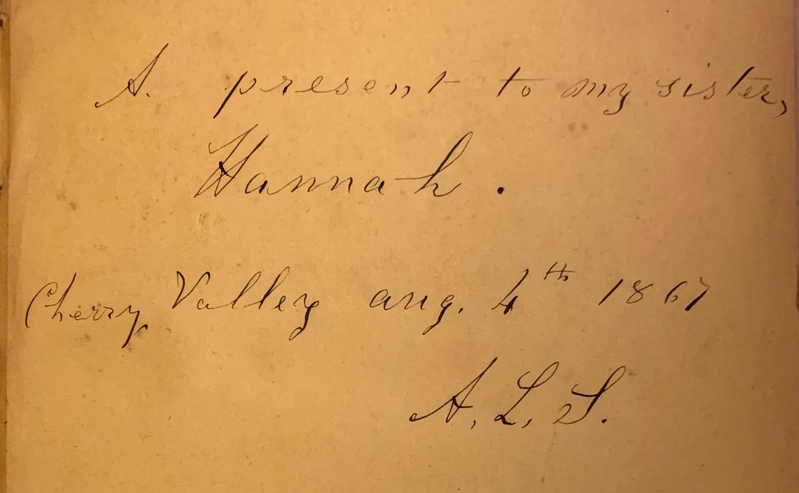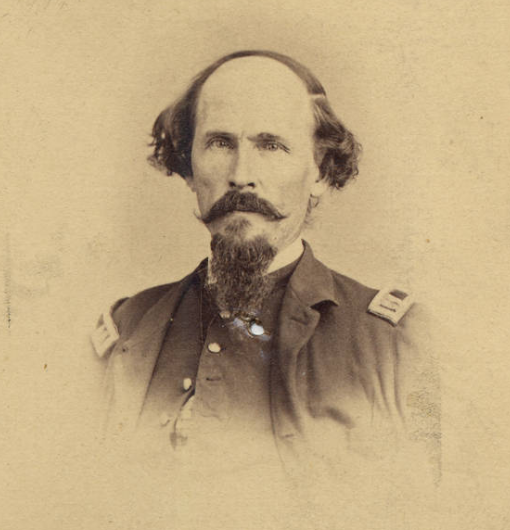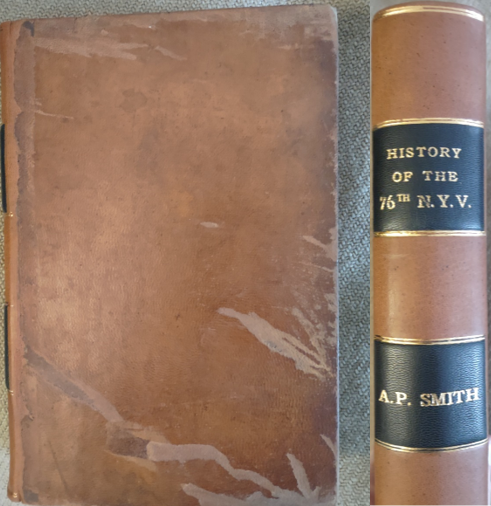Saving A Worn-Out Book: Amos Swan and a Regimental History
For several years, I have been interested in the 76th New York Infantry. I’ve written articles about them, and I collect artifacts the veterans held dear. When I had the rare opportunity to purchase an original copy of the 1867 regimental history, I had to follow through! Though it was in poor condition, with several structural issues and damage, it had an inscription from the original owner. Researching his initials revealed the story of a Civil War officer, a man well known for his craft pre-war who was wounded a shocking FIVE times during his service. With careful help from a professional, the book is now repaired and ready to survive another 150 years.

Though I had a pretty good idea who A.L.S. was, a website run by those who research the unit had a scan of another soldier’s paperwork. The penmanship signed on the paperwork matches that in this book! A little bit of genealogy work also revealed Hannah Swan, a slightly younger sister who remained in Massachusetts, which further confirms the identification. How the book passed from Hannah’s hands to ultimately mine, I have no idea, but I am confident that this book was a gift from Amos Latamer Swan, Brevet Lt. Col. Of the 76th.

Amos Swan’s father died when he was only seven years old in 1825, and he was sent to live with distant relatives. He learned to be a machinist, a locksmith, and silversmithing before settling down in Cherry Valley, New York. Before the war, he ran a cabinet shop where he also built caskets and melodeons, and some of the reed-organ instruments survive to this day. As the head of a local militia, Amos was mustered in as Captain of Company H, 76th NY in October 1861.
He had a hard service. Engaged alongside westerners that would later be known as the Iron Brigade at the Second Battle of Manassas, Swan was badly wounded in the hip. He wrote a local paper that “My wound to be sure, is painful, but I think will soon heal. The ball entered the back part of my thigh near the hip and struck the bone so hard that it battered the ball up as if it had struck a rock. It must come very near indeed to shattering the bone. … an instant sooner I was faced the other way, and if the ball had come then it would have struck in the groin or just below and severed the great artery, and all would soon been over…. It was a terrible fight for a short one.” At the battle of Fredericksburg a shell burst so close to him that it embedded powder in his face that could still be seen in 1867, and at Pollock’s Mill Creek before Chancellorsville he took a shell fragment to his thigh. Finally, at the regiment’s most trying moment at the battle of Gettysburg as the lead Union infantry regiment, Swan was struck by minie balls in his breast and right arm. He was wounded a shocking five times, and most of the wounds were severe.

In the winter of 1863, Swan tendered his resignation, as his earlier hip wound now made him unable to keep in the field. A brief biography printed in this very regimental history records “His resignation was reluctantly accepted. He has since been honored with a commission as Brevet Lieutenant-Colonel, for ‘faithful and meritorious services,’ and no brevet could be more worthily bestowed.“ His son, Edwin Judd Swan also served in the 76th. He enlisted as a private in his father’s company and rose through the ranks, ultimately reaching the rank Captain after the massive casualties at Gettysburg. Edwin was captured at the Wilderness and held as a prisoner for a year before escaping and returning to his regiment.
Interestingly enough, the building that once hosted Swan’s successful shop is now a bookstore specializing in used and rare books. That feels fitting, and I hope that a few books about Swan, his local community, and his unit at war pass between hands there. At that shop, he may have even worked with Samuel Morse himself on telegraphs!

Unfortunately, upon arrival from the original seller it was very clear that the 1867 “budget” leather binding was in poor condition. The bottom sewing of the book was broken, and the spine had partially split and been taped over. So, I sent the book directly to friend of ECW Chris at Rock Top Bookshop and Bindery in Cashtown, Pennsylvania. He carefully worked to restore and save the book while keeping as much “originality” as possible. He “rebacked” it, placing a new spine on and matching the existing covers. While it doesn’t perfectly match in the way new boards would, I asked him to do it this way in order to preserve the original covers that were well worn by the hands of the Swan family. Chris did a fantastic job, and his shop is worth a stop the next time you are near Gettysburg, whether to browse the extensive bookstore, hunt for out-of-print books, or to consult him on your own book restoration projects.

Interesting. Thanks for the tip on Rock Top. I have an original copy of the 1866 Joint Committee on Reconstruction Report that is in dire need of rebinding, and may give your friend a try the next time I am in Gettysburg.
Nice book! You’ll have to get their expert’s eye on it, but they might be able to help with that.
Excellent and interesting article…thanks!
Thanks George!
Great read. I hear good things about the Cashtown Book Store. I need to stop there during my next Gettysburg pilgrimage.
You should! Cashtown has some battle stories, but the bookshop is a main highlight with good finds.
Good on you for saving that regimental with some of its character intact! For some of us, a digital copy wouldn’t even be similar.
This one, as good as it looks, is a little too worn for heavy handling. I wouldn’t read it cover to cover. I use a modern reprint most of the time, though I do use a digital copy sometimes to find specific passages faster.
I am thrilled to see this! Amos is my 3rd great grandfather. His son Edwin and another son George both moved to Indiana before 1870. I was aware of much of his war history, and that he served under Abner Doubleday, but I have never seen this picture of him or a sample of his handwriting. Thank you!
Could you please contact me, when you get a chance, would like to see what kind of information you have on the family, as I have been charged with doing the family tree for my family. Thanks in advance.email: hdmanscustoms@yahoo.com and also on Facebook
That’s incredible! I’m glad you found this article and could connect it to your family story.
My cousin sent me a link to this article, because Amos is our 3xgreat grandfather,one of his sons also served in the 76th with him.
Ken, I’m also glad your branch of the family learned about my article. Hope it was useful and interesting!